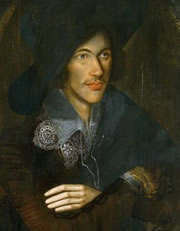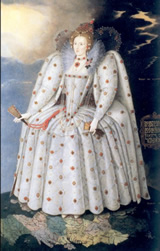
John Donne as a melancholy lover about 1595
When a cache of old letters was recently found in a laundry room in Switzerland, a letter by John Donne was estimated to be worth $250,000. Donne was something of a specialist in writing letters to great ladies in order to win favour, and the letter was penned to Lady Kingsmill in 1624 to console her on the death of her husband.
Unlike Shakespeare, whose portraits are always being discredited, we have no doubt what John Donne looked like at various stages of his life since he was fond of having his image captured. He had himself etched, sketched, engraved, miniaturized, painted in flamboyant costumes, and even carved in marble for his great effigy in St Paul’s cathedral in London.
This sexy picture of “Jack Donne” as a melancholy lover in a big floppy hat, open collar, and crossed arms has been called “the most famous of all Elizabethan love portraits.” The Latin inscription translates as O Lady Lighten Our Darkness, suggesting that Donne had himself painted for one of his mistresses around the time that he wrote his most famous elegy, “To His Mistress Going to Bed.”

Queen Elizabeth
Donne died in 1631 and his picture in the shadows, as he called it, was lost from the seventeenth to the twentieth century. It eventually came to light at Newbattle Abbey in 1959. The name had been written Duns, and mistaken for Duns Scotus! In May 2006, the painting was bought by the National Portrait Gallery in London, after an enthusiastic campaign to raise the £2M. BBC News covered the fundraising step by step, announcing triumphantly at the close, “John Donne Portrait Saved for Nation“. The restored painting has just been hung in Room 2 of the National Portrait Gallery with portraits of Queen Elizabeth and Elizabethan courtiers and poets.
